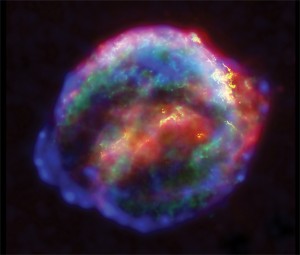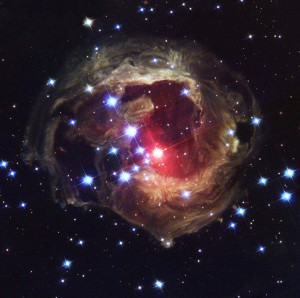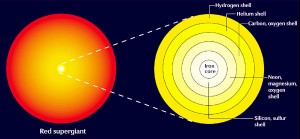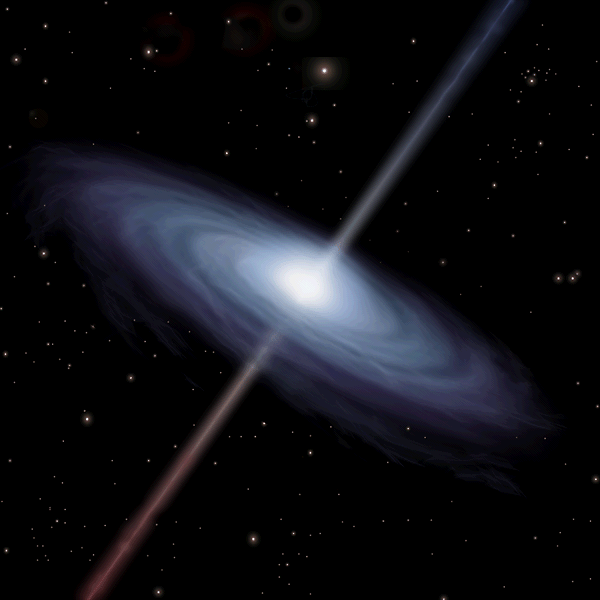Supernova Spotting
Thursday, March 2nd, 2017March 2, 2017
Time operates on an epic scale among the stars and galaxies of outer space. Some stars exist for millions of years but then suddenly undergo rapid changes and explode within months. In October 2013, an international team of scientists led by Ofer Yaron, an astrophysicist at the Weizmann Institute of Science in Israel, detected and studied a supernova that occurred in a distant galaxy within three hours of the explosion’s light first reaching Earth. Thanks to the timely observations, the team was able to learn a lot about the star and the explosion that consumed it. The team published its findings in February 2017 in the journal Nature Physics.

Supernova 1604 was a star that exploded in our own galaxy. The supernova blasted off the shell of gas and dust seen in this false-color composite image. The shell continues to expand at around 2,000 kilometers (1,200 miles) per second. The German astronomer Johannes Kepler observed the explosion in 1604. Credit: NASA/ESA/JHU/R. Sankrit & W. Blair
A supernova is an exploding star that can become billions of times as bright as our sun before gradually fading from view. At its brightest, a supernova may outshine an entire galaxy. The explosion throws a large cloud of gas into space at speeds of up to 10 percent of the speed of light, which is 186,282 miles (299,792 kilometers) per second. The mass of the expelled material may exceed 10 times the sun’s mass. Most supernovae reach their peak brightness in one to three weeks and shine intensely for several months.

A red supergiant called V838 Monocerotis glows at the center of a dust cloud in this photograph taken by the Hubble Space Telescope. In 2002, the star gave off a brilliant flash of light, becoming 600,000 times as bright as the sun. The flash illuminated dust thrown off the star during a previous outburst. Credit: NASA/ESA/H.E. Bond (STScI)
The exploding star examined by Yaron and his associates was a red supergiant. Such stars are dozens of times larger than our sun, which is a main sequence star or yellow dwarf. Red supergiants have relatively short life spans, however, existing for “only” millions of years. In contrast, our sun is expected to live some 10 billion years. All stars produce energy through the process of nuclear fusion, a joining of two atomic nuclei (cores) to produce a larger nucleus. Fusion releases a huge amount of energy. Most stars fuse hydrogen or helium, but a supergiant quickly (over millions of years) burns through its fuel supply and begins to fuse heavier elements together in its core. At this point, a supergiant’s days are numbered. Each new level of fusion chips away at its core, slowly killing the star. At a critical point, the star quickly fuses its available silicon into iron. Once the core fills with iron, the star will collapse and rebound in an explosive supernova.

Click to view larger image
A huge star creates chemical elements by nuclear fusion, the joining of two atomic nuclei to make a larger nucleus. In the outermost shell, hydrogen nuclei fuse, creating helium. In the next shell, helium fuses to make carbon and oxygen. Fusion creates successively heavier elements in shells closer to the core, where iron is produced. The shells in this diagram are not drawn to scale. Credit: WORLD BOOK diagram
Based on the patterns of light emitted by the supernova in question, Yaron and the team discovered that the star had blown off a layer of material into space about a year before the explosion. They suspect that this layer has to do with a change in fusion fuel at the star’s core shortly before it went supernova. The transition itself was violent, setting off a chain reaction within the star that shot a layer of star matter into space ahead of the supernova.
The discovery was made with the help of an ever-improving array of automated survey telescopes. Such telescopes capture images of a certain portion of the night sky. A computer then compares the images against earlier pictures of the same section of sky, looking for changes. If it detects any, the computer alerts a human astronomer to investigate the findings.
Astronomers are eagerly awaiting the next supernova to occur in the Milky Way. They estimate that a supernova occurs once every 100 years or so in our galaxy, but they are not always visible to Earth-bound observers. The last local supernova seen on Earth occurred in 1604, when German astronomer Johannes Kepler observed what he thought was a new star in the night sky. The most recent intragalactic (within our galaxy) supernova occurred around 1900, but its light was obscured by dust. Scientists were only able to study it 100 years later with instruments such as the orbiting Chandra X-Ray Observatory and the National Radio Astronomy Observatory’s Very Large Array near Socorro, New Mexico. If we’re lucky enough for the next supernova to be close (but not too close), we can learn more about the largest stars and the brilliant ends of their lives.



